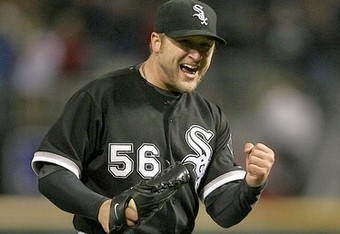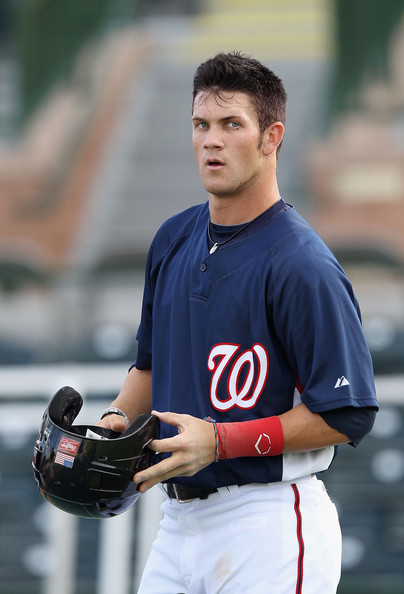Over the next six weeks, Washington Nationals team General Manager Mike Rizzo will burn up the phone lines at Nationals Park as he searches for the one or two remaining pieces that will transform the once moribund franchise into—this seems almost sacrilege to say—a true pennant contender.
 |
| Roy Oswalt Tops Mike Rizzo's List For FA Pitchers |
As his team rocketed through September and finished the season on a 15-5 tear, Rizzo told reporters that his team was one starting pitcher and a center fielder away from joining the elite of the National League East.
Many free agent pitchers have been mentioned as possibilities for the Nationals rotation, including Mark Buerle (13-9, 3.59), Roy Oswalt (9-10, 3.69) and C.J. Wilson (16-7, 2.94).
And though the Nationals have three stalwart prospects to fill that last spot in the rotation, Tommy Milone (1-0, 3.81), Brad Peacock (2-0, 0.75) and Ross Detwiler (4-5, 3.00) have yet to pitch a meaningful September game in their young careers.
Though their potential is undeniable, their lack of experience could be deadly to a potential pennant chase. The Nationals need a veteran quality starter to help calm the inevitable summer storms.
But the need for a center fielder is another matter entirely.
Heading into spring training, Michael Morse is a lock in left. After filling in at first when Adam LaRoche was lost for the year in mid May, the 29-year-old returns to his natural position after blossoming at the plate. Morse was perhaps the surprise of the National League last year, hitting .303-31-95 in his first season as a full-time player.
Jayson Werth is penciled in as the team’s right fielder. Werth’s first year in Washington was perhaps the team’s worst individual effort since Cristian Guzman back in 2005. In 150 games, the 32-year-old hit just .232-20-58.
But there is little doubt that Werth’s horrid season is likely not to be repeated in 2012. In his last three seasons with the Phillies, Werth averaged .279-29-84 with a solid .376 on-base percentage.
Chalk up last year to a combination of “just one of those years” and trying too hard to justify his $126 million contract.
That said, playing in that Philadelphia bandbox certainly puffed up his home run stats. From 2008 through 2010, Werth hit 50 homers at home and just 37 on the road.
The combination of a rebound year in 2012 along with the more spacious home ballpark should mean that Werth will give the Nationals a good-but-not-great season, something along the lines of .270-20-75.
That leaves the hole in center and a myriad of players to fill it. Grady Sizemore, who was non-tendered by the Indians following three injury-plagued seasons, seems the most logical choice of the group, though how much interest the team has for him at this point isn’t known.
 |
| Sizemore May Resign With Indians |
Sizemore, a former member of the organization, averaged just .234-9-36 over the last three after hitting .279-28-81 from 2006-2008. Sizemore is seeking a one-year contract to prove his health as well as his worth.
And after his one year in center, he would move on to greener pastures, giving up his spot to that remarkable phenom currently percolating in the minors, Bryce Harper.
But as badly as the team wants to bring along the 19-year-old along slowly and cautiously, he seems to be proving at every stop along the way that he’s ready to face major league pitching right now.
Harper, the top overall pick in the MLB Amateur Draft in 2010, graduated from high school two years early and played in an advanced junior college league that used wood bats.
Hitting against 19-year-old pitchers in what should have been his junior year of high school, Harper was unstoppable, batting .442-29-89 in just 215 at-bats. That works out to 72 homers and 222 RBI over a 162-game season. Wow.
Harper’s first taste of professional baseball came in the Nationals’ Florida Instructional League following the 2010 season. He Batted .319 with a .407 on-base percentage and led his team in hits, home runs and runs batted in.
Though he originally was not ticketed to play in the highly touted Arizona Fall League that fall, Harper’s outstanding effort earned a spot on his team’s taxi squad, which limited his play to a couple of starts a week.
That said, the second-youngest player ever to participate in the AFL batted .343 with a .629 slugging percent in limited play.
Harper earned some significant playing time during the 2011 spring training, playing in 13 early games and he responded by hitting .389 with a .450 on-base percentage and a 1.006 OPS.
Like at virtually every other stop he’d made as a professional, Harper started slowly in the Low-A South Atlantic League as a member of the Hagerstown Suns this spring. But like virtually every stop he’s made, Harper then got hot and for six weeks, he was the hottest hitter in the league, perhaps in all of baseball. And then, like at virtually every stop he’s made, he plateaued and continued to be a very good player for the remainder of the season.
 |
| Bryce Harper |
After 72 games, Harper had batted .318/.423/.554 with 14 home runs and 46 RBI and was promoted to Double-A Harrisburg. It was there that his cycle of slow starts and hot streaks ended. Oh, the slow start happened, but just as he began to heat up, injury ended his season.
In 129 at-bats, Harper hit .256/.329/.395 with 3 home runs and 12 RBI for the Senators.
There was some concern that the semi-struggle at Harrisburg was more the product of his being pushed too far too quickly within the Nationals’ system, but those fears were allayed over the past month in the hot desert sun in Arizona.
Playing against the top prospects across major league baseball, Harper batted .333/.400/.634 with six home runs and 26 RBI. Adjusted to a full major league season, those numbers would be .333-36-156 with 24 stolen bases.
And, oh yeah, he started slowly, then destroyed opposition pitching for three weeks, then plateaued and played solid baseball through the season’s end.
Now, I agree that it is difficult look at all of those teams and accompanying stats and be able to tell just how well he did. So let’s add up every swing, punch-out and home run he’s produced from that first day of spring training through the final out of the just completed Arizona Fall League season.
It pretty much adds up to a full major league season and gives a fairly good indication of the type of player Bryce Harper is:
Slash Line: .307/.398/.535
At-Bats: 498
Runs: 83
Hits: 153
Doubles: 32
Triples: 4
Home Runs: 23
Runs Batted In: 84
Stolen Bases: 31/38 (81.5%)
Walks: 73
Strikeouts: 111
That’s outstanding on a number of levels.
In the Low-A South Atlantic League, Harper was 18 playing against pitchers four years older than him. In the Double-A Eastern League, the median age is 25; some of those guys were in their eighth professional season while Harper should have been a senior in high school.
If he was able to put up all-star numbers when he was in essence the little brother trying to hit against all the neighborhood big brothers, how might he fare against players of his own age and experience level?
I don’t think we’ll ever know the answer to that because it’s not going to happen, because when the Nationals break camp and go north next spring, Bryce Harper needs to go with them.
It is a near certainty that whoever the Nationals are going to sign to play center, he will be gone by the end of the year, opening the door for Harper to begin playing every day in 2013.
But he’s ready now, and so that stop-gap center fielder just isn’t necessary.
The most important part of a young player’s game is the ability to adjust, and Harper’s continuous cycle of slow starts followed by blazing hot streaks is just that, Harper getting overmatched and then adjusting to how he’s being pitched.
There is no reason to believe that won’t happen at the major league level too. I have little doubt that Harper’s first couple of months would be beset by strikeouts and prolonged slumps. But in time, he would make the necessary adjustments and provide enough offense for the Nationals to make a real run at the post season.
Some worry that a bad start might harm Harper’s confidence in himself. But one thing that Harper doesn’t lack is confidence. And bad starts don’t end a player’s season before it starts. After 30 games last year, Michael Morse was hitting just .211/.253/.268 with a home run and just nine RBI, and his season ended quite nicely.
Jayson Werth’s first 30 games were almost as bad, and though he didn’t totally climb out of the hole he had dug for himself, he came close.
So there is no reason to believe that Harper couldn’t do the same, especially when he has a nice track record of doing just that.
And history suggests that Harper can make the jump to the majors this year.
Back in 1989, there was a 19-year-old phenom who many compare today to Bryce Harper. His name was Ken Griffey Jr. In his first few weeks as a major leaguer, he struggled mightily, hitting just .189/.246/.340 through early May.
But he made adjustments, learned from his mistakes, and by the end of the year hit .264-16-61 and finished third in Rookie of the Year balloting.
I suspect that Harper’s first-year stats would closely mirror those of Griffey, giving the team’s outfield more than enough offensive production to make a real run at the post season.
An outfield of Michael Morse, Jayson Werth and Bryce Harper could produce 70 home runs and 250 RBI in 2012. That compares favorably to the New York Yankees outfield trio of Brett Gardner, Curtis Granderson and Nick Swisher who combined to hit 71 home runs and drive in 240 RBI last year.
Starting Bryce Harper on Opening Day, does, however, have its drawbacks. His arbitration and free agency clocks would begin sooner, costing the team certainly more money and possibly the loss of Harper to free agency at an earlier date.
But in the here and now, none of that really matters. The Washington Nationals are finally in a position to win next year, thanks to equal parts of better players, the softening of the competition, and the possibility of a second wildcard spot in the playoffs.
In baseball, windows of opportunity open and close all too quickly and every chance to win needs to be grasped. For the Nationals, Grady Sizemore or Coco Crisp wouldn’t provide any better chance to win next year than Bryce Harper.
That being the case, it makes more sense to start Harper in right, move Werth to center, and leave Morse in left. Sure, there is a chance that Harper’s first year in the majors may be a bit substandard, but there is enough talent on the roster to make up for any short-term difficulties he may face.
And there is no question that Bryce Harper circa 2013 would be a far better player having a year of major league experience under his belt rather than another season in the minors.
While the Nationals can contend next year, 2013 will likely be the Nationals’ “big” year. The imperfections in the games of Danny Espinosa, Wilson Ramos and Ian Desmond will likely be gone with another year of experience. So it’s better to make













